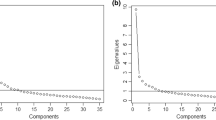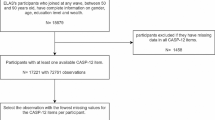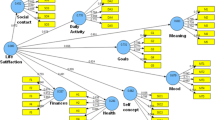Abstract
Accurate quality of life assessment is crucial for the development of our understanding of positive ageing. The Older People’s Quality of Life Scale (OPQOL) is a measure developed for use with older adult samples; however, its factor structure remains unclear and measurement consistency across population subgroups has not yet been confirmed. 432 Australian older adults aged 65+ completed the OPQOL as part of a telephone survey. An exploratory factor analysis (EFA; Mplus) was conducted to clarify the factor structure, while confirmatory factor analyses (CFA) were run to confirm measurement invariance across age and gender subgroups. Application of a CFA to the original 32-item OPQOL yielded poor model fit. A subsequent EFA suggested a six-factor solution incorporating 23 of the original items. Measurement invariance of the proposed model was determined via a series of CFAs that demonstrated acceptable-to-good model fit and supported configural, metric and scalar invariance across both age and gender. A shorter version of the OPQOL that provides both a total and subscale scores is proposed, but the model requires further confirmation via CFA in other English-speaking samples. This version of the OPQOL demonstrates consistency of measurement across age and gender, which suggests that scores can be meaningfully compared between groups.
Similar content being viewed by others
Data Availability
Data are available through email request to the corresponding author.
Code Availability
Syntax are provided in the attached supplemental materials.
Change history
11 June 2022
A Correction to this paper has been published: https://doi.org/10.1007/s12144-022-03291-9
References
Altman, D. G., & Royston, P. (2006). The cost of dichotomising continuous variables. The British Medical Journal, 332(7549), 1080. https://doi.org/10.1136/bmj.332.7549.1080
Atienza, F. L., Balaguer, I., & García-Merita, M. A. L. (2003). Satisfaction with life scale: Analysis of factorial invariance across sexes. Personality and Individual Differences, 35(6), 1255–1260. https://doi.org/10.1016/S0191-8869(02)00332-X
Australian Bureau of Statistics. (2017). 2016 Census QuickStats: Onkaparinga (C). Retrieved 24/09/2020 from https://quickstats.censusdata.abs.gov.au/census_services/getproduct/census/2016/quickstat/LGA45340
Baltes, P. B., & Smith, J. (2003). New frontiers in the future of aging: From successful aging of the young old to the dilemmas of the fourth age. Gerontology, 49(2), 123–135. https://doi.org/10.1159/000067946
Bontempo, D. E., Hofer, S. M., & Lawrence, F. J. (2007). Assessing factorial invariance in cross-sectional and longitudinal studies. In A. D. Ong & M. H. M. van Dulmen (Eds.), The Oxford handbook of methods in positive psychology (Vol. 153175). Oxford University Press.
Bowling, A. (2009). The psychometric properties of the older people's quality of life questionnaire, compared with the CASP-19 and the WHOQOL-OLD. Current Gerontology and Geriatrics Research. https://doi.org/10.1155/2009/298950.
Bowling, A. (2018). Measuring the quality of later life. In A. Walker (Ed.), The New Dynamics of Ageing (Vol. 1, pp. 81 - 101). https://www.jstor.org/stable/j.ctt21216v3.10
Bowling, A., & Stenner, P. (2011). Which measure of quality of life performs best in older age? A comparison of the OPQOL, CASP-19 and WHOQOL-OLD [article]. Journal of Epidemiology and Community Health, 65(3), 273–280. https://doi.org/10.1136/jech.2009.087668
Bowling, A., Hankins, M., Windle, G., Bilotta, C., & Grant, R. (2013). A short measure of quality of life in older age: The performance of the brief older People's quality of life questionnaire (OPQOL-brief) [article]. Archives of Gerontology and Geriatrics, 56(1), 181–187. https://doi.org/10.1016/j.archger.2012.08.012
Cabrera-Nguyen, P. (2010). Author guidelines for reporting scale development and validation results in the Journal of the Society for Social Work and Research. Journal of the Society for Social Work and Research, 1(2), 99–103. https://doi.org/10.5243/jsswr.2010.8
Carstensen, L. L., Fung, H. H., & Charles, S. T. (2003). Socioemotional selectivity theory and the regulation of emotion in the second half of life. Motivation and Emotion, 27(2), 103–123. https://doi.org/10.1023/A:1024569803230
Chen, F. F. (2007). Sensitivity of goodness of fit indexes to lack of measurement invariance. Structural Equation Modeling: A Multidisciplinary Journal, 14(3), 464–504. https://doi.org/10.1080/10705510701301834
Chen, F. F. (2008). What happens if we compare chopsticks with forks? The impact of making inappropriate comparisons in cross-cultural research. Journal of Personality and Social Psychology, 95(5), 1005–1018. https://doi.org/10.1037/a0013193
Chen, Y., Hicks, A., & While, A. E. (2014). Validity and reliability of the modified Chinese version of the older people's quality of life questionnaire (OPQOL) in older people living alone in China [Article]. International Journal of Older People Nursing, 9(4), 306–316. https://doi.org/10.1111/opn.12042
Dobriban, E., & Owen, A. B. (2019). Deterministic parallel analysis: An improved method for selecting factors and principal components. Journal of the Royal Statistical Society: Series B (Statistical Methodology), 81(1), 163–183.
Grant, R. L., & Bowling, A. (2011). Challenges in comparing the quality of life of older people between ethnic groups, and the implications for national well-being indicators: a secondary analysis of two cross-sectional surveys. Health and Quality of Life Outcomes, 9(1), 109. https://doi.org/10.1186/1477-7525-9-109
Gregorich, S. E. (2006). Do self-report instruments allow meaningful comparisons across diverse population groups? Testing measurement invariance using the confirmatory factor analysis framework. Medical Care, 44(11 Suppl 3), S78.
Henson, R. K., & Roberts, J. K. (2006). Use of exploratory factor analysis in published research: Common errors and some comment on improved practice. Educational and Psychological Measurement, 66(3), 393–416. https://doi.org/10.1177/0013164405282485
Hess, T. M. (2014). Selective engagement of cognitive resources: Motivational influences on older adults’ cognitive functioning. Perspectives on Psychological Science, 9(4), 388–407. https://doi.org/10.1177/1745691614527465
Howard, M. C. (2016). A review of exploratory factor analysis decisions and overview of current practices: What we are doing and how can we improve? International Journal of Human-Computer Interaction, 32(1), 51–62. https://doi.org/10.1080/10447318.2015.1087664
Hurley, A. E., Scandura, T. A., Schriesheim, C. A., Brannick, M. T., Seers, A., Vandenberg, R. J., & Williams, L. J. (1997). Exploratory and confirmatory factor analysis: Guidelines, issues, and alternatives. Journal of Organizational Behavior: The International Journal of Industrial, Occupational and Organizational Psychology and Behavior, 18(6), 667-683. 10.1002.
Hyde, M., Wiggins, R. D., Higgs, P., & Blane, D. B. (2003). A measure of quality of life in early old age: The theory, development and properties of a needs satisfaction model (CASP-19) [article]. Aging and Mental Health, 7(3), 186–194. https://doi.org/10.1080/1360786031000101157
Izquierdo Alfaro, I., Olea Díaz, J., & Abad García, F. J. (2014). Exploratory factor analysis in validation studies: Uses and recommendations. Psicothema, 26(3), 395–400. https://doi.org/10.7334/psicothema2013.349
Ko, H., Park, Y.-H., Cho, B., Lim, K.-C., Chang, S. J., Yi, Y. M., Noh, E.-Y., & Ryu, S.-I. (2019). Gender differences in health status, quality of life, and community service needs of older adults living alone. Archives of Gerontology and Geriatrics, 83, 239–245. https://doi.org/10.1016/j.archger.2019.05.009 Free article.
Kolenikov, S., & Bollen, K. A. (2012). Testing negative error variances: Is a Heywood case a symptom of misspecification? Sociological Methods & Research, 41(1), 124–167.
Li, C.-H. (2016). Confirmatory factor analysis with ordinal data: Comparing robust maximum likelihood and diagonally weighted least squares. Behavior Research Methods, 48(3), 936–949. https://link.springer.com/content/pdf/10.3758/s13428-015-0619-7.pdf
Lowsky, D. J., Olshansky, S. J., Bhattacharya, J., & Goldman, D. P. (2014). Heterogeneity in healthy aging. Journals of Gerontology Series A: Biomedical Sciences Medical Sciences, 69(6), 640–649.
Mares, J., Cigler, H., & Vachkova, E. (2016). Czech version of OPQOL-35 questionnaire: The evaluation of the psychometric properties [Article]. Health and Quality of Life Outcomes, 14(1), Article 93. https://doi.org/10.1186/s12955-016-0494-7.
Meredith, W. (1993). Measurement invariance, factor analysis and factorial invariance. Psychometrika, 58(4), 525–543.
Meredith, W., & Teresi, J. A. (2006). An essay on measurement and factorial invariance [Review]. Medical Care, 44(11 SUPPL. 3), S69-S77. https://doi.org/10.1097/01.mlr.0000245438.73837.89.
Muthèn, L. K., & Muthèn, B. O. (2010). MPlus User's Guide. Muthèn & Muthèn.
Muthen, B., & Muthen, L. (2016). The residual covariance matrix. http://www.statmodel.com/cgi-bin/discus/discus.cgi?pg=next&topic=9&page=7298.
Nikkhah, M., Heravi-Karimooi, M., Montazeri, A., Rejeh, N., & Sharif Nia, H. (2018). Psychometric properties the Iranian version of older People’s Quality of Life questionnaire (OPQOL) [article]. Health and Quality of Life Outcomes, 16(1), Article 174. https://doi.org/10.1186/s12955-018-1002-z
O'Toole, J., Sinclair, M., & Leder, K. (2008). Maximising response rates in household telephone surveys. BMC Medical Research Methodology, 8(1), 1–5. https://doi.org/10.1186/1471-2288-8-71
Pendergast, L. L., von der Embse, N., Kilgus, S. P., & Eklund, K. R. (2017). Measurement equivalence: A non-technical primer on categorical multi-group confirmatory factor analysis in school psychology [Article]. Journal of School Psychology, 60, 65–82. https://doi.org/10.1016/j.jsp.2016.11.002
Power, M., Quinn, K., & Schmidt, S. (2005). Development of the WHOQOL-old module. Quality of Life Research, 14(10), 2197–2214. https://doi.org/10.1007/s11136-005-7380-9
Putnick, D. L., & Bornstein, M. H. (2016). Measurement invariance conventions and reporting: The state of the art and future directions for psychological research. Developmental Review, 41, 71–90. https://doi.org/10.1016/j.dr.2016.06.004
Sargent-Cox, K. A., Rippon, M., & Burns, R. A. (2014). Measuring anxiety about aging across the adult lifespan. International Psychogeriatrics, 26(1), 135–145. https://doi.org/10.1017/S1041610213001798
Schmidt, S., & Bullinger, M. (2003). Current issues in cross-cultural quality of life instrument development. Archives of Physical Medicine and Rehabilitation, 84, S29–S34.
Schmitt, T. A. (2011). Current methodological considerations in exploratory and confirmatory factor analysis. Journal of Psychoeducational Assessment, 29(4), 304–321. https://doi.org/10.1177/0734282911406653
Schumacker, R. E., & Lomax, R. G. (2010). A beginners guide to structural equation modelling. Routledge.
Skevington, S. M. (2002). Advancing cross-cultural research on quality of life: Observations drawn from the WHOQOL development. Quality of Life Research, 11(2), 135–144. https://doi.org/10.1023/a:1015013312456
Svantesson, U., Jones, J., Wolbert, K., & Alricsson, M. (2015). Impact of physical activity on the self-perceived quality of life in non-frail older adults. Journal of Clinical Medicine Research, 7(8), 585. https://doi.org/10.14740/jocmr2021w.
Tabachnick, B. G., & Fidell, L. S. (2007). Using multivariate statistics 5th edition. Pearson Education Inc..
Vallance, J. K., Eurich, D. T., Gardiner, P. A., Taylor, L. M., Stevens, G., & Johnson, S. T. (2014). Utility of telephone survey methods in population-based health studies of older adults: An example from the Alberta older adult health behavior (ALERT) study. BMC Public Health, 14(1), 1–8.
Weber, W., Reinhardt, A., & Rossmann, C. (2020). Lifestyle segmentation to explain the online health information–seeking behavior of older adults: Representative telephone survey. Journal of Medical Internet Research, 22(6), e15099. https://doi.org/10.2196/15099
Weinberger, M., Oddone, E. Z., Samsa, G. P., & Landsman, P. B. (1996). Are health-related quality-of-life measures affected by the mode of administration? Journal of Clinical Epidemiology, 49(2), 135–140.
Worthington, R. L., & Whittaker, T. A. (2006). Scale development research: A content analysis and recommendations for best practices. The Counseling Psychologist, 34(6), 806–838. https://doi.org/10.1177/0011000006288127
Funding
This research was supported by the Australian Government through the Australian Research Council’s Linkage Projects funding scheme (project LP170100461) in partnership with ECH Inc., Onkaparinga City and the South Australian Government Office for Ageing Well. The views expressed herein are those of the authors and are not necessarily those of the Australian Government, Australian Research Council, or other partner organisations.
Author information
Authors and Affiliations
Contributions
All authors contributed to the study conception and design. Material preparation, data collection and analysis were performed by J E T Scott and T D Windsor. The first draft of the manuscript was written by J E T Scott and all authors commented on previous versions of the manuscript. All authors read and approved the final manuscript.
Corresponding author
Ethics declarations
Conflicts of Interest/Competing Interests
None to declare.
Additional information
Publisher’s note
Springer Nature remains neutral with regard to jurisdictional claims in published maps and institutional affiliations.
The original version of this article has been revised. The word “Revised manuscript:” from the title has been removed.
Supplementary Information
ESM 1
(DOCX 35 kb)
Rights and permissions
About this article
Cite this article
Scott, J.E.T., Mazzucchelli, T.G., Luszcz, M.A. et al. Factor structure and measurement invariance of the older people’s quality of life scale. Curr Psychol 42, 12732–12742 (2023). https://doi.org/10.1007/s12144-021-02507-8
Accepted:
Published:
Issue Date:
DOI: https://doi.org/10.1007/s12144-021-02507-8




